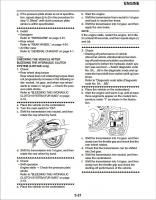majicmaker
Well-known member
Hello, Boys and Girls. Im in need of some technical expertise. I have the 06AE model. AS on the other side of the pond. Im getting a sh-16 error code. The transmission isnt shifting into gear from neutral with the trigger shifter or the foot shifter.
The FSM says I need a replace the MCU for this fault. Im absolutely willing to do that if that is in fact the problem but, Im going through everything that can cause that fault first.
1) I disconnected (repeatedly) every electrical connector I could get to in the YCCS system and applied dielectric silicone on both ends to make sure I didnt have any dirty or corroded pins.
2) I noticed that I have a significant leak at the mating surface of the Clutch Release Cylinder. I gave Brodie a shout out (again) and he said that leak smells like a smoking gun and I agree. Loss of clutch fluid can cause that fault.
The technical expertise I need right now is with flushing and bleeding the clutch fluid. Im quite familiar with flushing clutch fluid systems but, the AE isnt as straight forward as the A models. I remember a few folks along the way stating that theres several things in the bleeding process that has to be performed on the AE that doesnt on the A.
Thanks in advance. Any and all help will be appreciated.
Cheers
The FSM says I need a replace the MCU for this fault. Im absolutely willing to do that if that is in fact the problem but, Im going through everything that can cause that fault first.
1) I disconnected (repeatedly) every electrical connector I could get to in the YCCS system and applied dielectric silicone on both ends to make sure I didnt have any dirty or corroded pins.
2) I noticed that I have a significant leak at the mating surface of the Clutch Release Cylinder. I gave Brodie a shout out (again) and he said that leak smells like a smoking gun and I agree. Loss of clutch fluid can cause that fault.
The technical expertise I need right now is with flushing and bleeding the clutch fluid. Im quite familiar with flushing clutch fluid systems but, the AE isnt as straight forward as the A models. I remember a few folks along the way stating that theres several things in the bleeding process that has to be performed on the AE that doesnt on the A.
Thanks in advance. Any and all help will be appreciated.
Cheers

































































